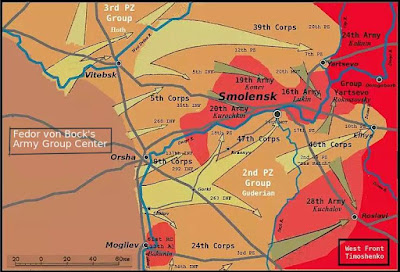The Battle of Smolensk was a WW2 military engagement during which the Wehrmacht forces defeated four Soviet armies in a tight encirclement. It was fought between July 10 and July 27, 1941. It was part of Operation Barbarossa, which had begun on June 22, 1941. To achieve a quick victory, the powerful German units of Army Group Center, under Fedor von Bock, had to tear out gaps at several points on the Soviet defense line. In order to be able to punch big holes in the Russian defensive positions, fast armored divisions, self-propelled artillery, and ground attack aircraft were necessary to surprise and surround enemy units. This military maneuver is called lightning war (Blitzkrieg in German).
Military units involved
The northern jaw of the pincers movement was led by the 39th Corps (from Hermann Hoth’s 3rd Panzer Group), while the southern jaw was composed of the 47th and 46th Corps (from Heinz Guderian’s 2nd Panzer Group). Other secondary elements involved in the German encirclement were the 9th Army’s 5th Corps and the 4th Army’s 9th Corps.
The Soviet units that were trapped in the German Army Group Center’s pincers movement were the 13th Army (commanded by Remezov), the 20th Army (under Pavel Kurochkin), the 19th Army (led by Ivan Konev), and the 16th Army (commanded by Mikhail Lukin).
Summary
The Battle of Smolensk began on July 10,1941, when Heinz Guderian’s 2nd Panzer Group crossed the Dnieper River and wiped out the Soviet 13th Army, which had managed to get out of the Minsk Pocket as it moved eastwards towards Smolensk. Meanwhile, the 39th Corps of Hermann Hoth’s 3rd Panzer Group attacked further north.
By July 16th, Hoth’s armored units reached the sector east of Smolensk, while Guderian’s 2nd Panzer Group’s 47th Corps divisions spearheaded towards Smolensk. After fierce fighting, by July 26, the 39th Panzer Corps’ 20th Motorized Division (3rd Panzer Group) had managed to link up with the 47th Corps’ 17th Panzer Division (2nd Panzer Group).
Below, Map of the Smolensk encirclement


0 $type={blogger}:
Post a Comment